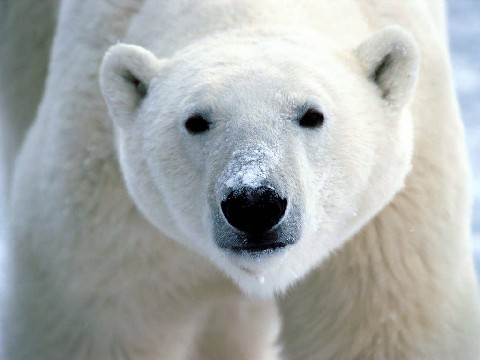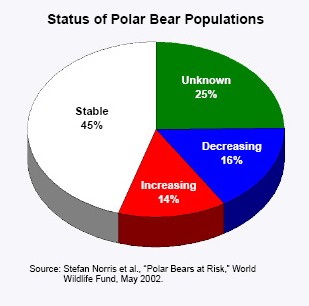 The United Nations has declared 2010 the International Year of Biodiversity.
The United Nations has declared 2010 the International Year of Biodiversity.
It was reported by the BBC that the International Union for Conservation of Nature and Natural Resources (IUCN) had drawn up what they call a “red list” and on each of the 365 days of 2010 will be featuring an example of an endangered animal on their website. The animal with start billing on New year’s Day was the polar bear.
Jane Smart, Director of IUCN’s Biodiversity Conservation Group stated: “….It’s time for governments to get serious about saving species and make sure it’s high on their agendas for next year, as we’re rapidly running out of time…”
Err. No love. There are indeed endangered species in the world but the polar bear is not among them!
We have of course seen the BBC footage of polar beard, holding on for dear life to bits of ice, their Arctic habitat been destroyed by “climate change”. It is of course a lie. Polar Bears are not endangered. There is no indication of any reduction of their populations. In fact, they are actually being hunted by locals who have to live with them, in an effort to keep their populations down. Of 13 Polar Bear populations, 11 are thriving and growing.
Below is a 2006 report reproduced from the URL http://www.ncpa.org/pub/ba551/ by H. Sterling Burnett who is a senior fellow with the National Center for Policy Analysis.
Recently, some scientists have claimed that human-caused global warming poses a significant threat to the survival of many species. For most species at risk, they argue, warming will cause the range of suitable habitat to shift faster than either the species (or their food sources) can move or adapt to a new range. For other species, they say, suitable habitat will cease to exist altogether. Among the species claimed to be at high risk of extinction from human-caused global warming is the charismatic polar bear.
Indeed, in February 2005 the Center for Biological Diversity filed a petition with the United States Fish and Wildlife Service to list the polar bear as endangered or threatened. The petition was later joined by the Natural Resources Defense Council and Greenpeace. In response, the USFWS initiated a formal status review to determine if the polar bear should be protected throughout its range.
A new NCPA study by Dr. David Legates, director of the University of Delaware’s Center for Climatic Research and state climatologist, examines the claim that global warming threatens to cause polar bear extinction and finds little basis for fear. By and large, the study finds that polar bear populations are in good shape.
Is the Arctic Warming? In the study, Climate Science: Climate Change and Its Impacts , Legates reviewed the claims that global warming is causing an unnatural increase in Arctic temperatures, posing a threat to the thickness and extent of sea ice and thus to the polar bears who rely upon it. In particular, he examined assertions made in the 2004 Arctic Climate Impact Assessment (hereafter, the Arctic Assessment ), an international project of the Arctic Council and the International Arctic Science Committee (IASC).
Legates finds that their claims of an impending, human-induced Arctic meltdown are not supported by the evidence. For example, the Arctic Assessment proclaimed that Arctic air temperature trends provide an early and strong indication that global warming is causing polar ice caps and glaciers to melt. However, current research suggests that coastal stations in Greenland are instead experiencing a cooling trend, and average summer air temperatures at the summit of the Greenland Ice Sheet have decreased at the rate of 4°F per decade since measurements began in 1987.
In addition, the Arctic Assessment ignored a relatively recent long-term analysis of records from coastal stations in Russia. Russian coastal-station records of both the extent of sea ice and the thickness of fast ice (ice fixed to the shoreline or seafloor) extending back 125 years show significant variability over 60- to 80-year periods. Moreover, the maximum air temperature reported for the 20th century was in 1938, when it was nearly 0.4°F warmer than in 2000. The Russian study concludes that actual temperature measurements do not show the increased warming predicted by computer climate models.
However, even if warming is occurring, it has happened before, as ice cores from Baffin Island and sea core sediments from the Chukchi Sea show. For example, in Alaska, the onset of a warming in 1976-1977 ended the multi-decade cold trend in the mid-20th century and simply returned temperatures to those experienced in the early 20th century. Sharp, substantial fluctuations are typical of the historic pattern of natural climate variability extending back several centuries. And, as expected in response to natural variability, Alaskan ecosystems have responded rapidly and visibly to this recent warmth. By contrast, if the recent warmth were human-induced by constant additions of greenhouse gases to the atmosphere, responses in the Arctic region would be expected to be gradual and modest when viewed within any short time period.

Is Warming Causing Sea Ice to Melt? According to the Arctic Assessment , human-caused warming in the Arctic will necessarily lead to decreased sea ice thickness and extent. However, air temperature is only one factor that influences sea ice; the frequency and velocity of the wind also has an effect. When the Arctic is relatively calm, it is easier for sea ice to develop. During stormy periods, surface winds churn the water and move existing ice, making it more difficult for sea ice to form.
A study commissioned by Canada’s Department of Fisheries and Oceans examined the relationship between air temperature and sea ice and concluded, “the possible impact of global warming appears to play a minor role in changes to Arctic sea ice.” Rather, the Canadian study found that changing wind patterns are the primary cause of changing sea ice distributions. Moreover, while sea ice has decreased in the Arctic, it has remained relatively constant (or even increased slightly) in the Antarctic since 1978.
Is Global Warming Killing Polar Bears? The Arctic Assessment concludes, “global warming could cause polar bears to go extinct by the end of the century by eroding the sea ice that sustains them.” According to the assessment, the threat to polar bears is threefold: changes in rainfall or snowfall amounts or patterns could affect the ability of seals, the bears’ primary prey, to successfully reproduce and raise their pups; decreased sea ice could result in a greater number of polar bears drowning or living more on land, negatively affecting their diet (forcing them to rely on their fat stores prior to hibernation); and unusual warm spells could cause the collapse of winter dens or force more bears into less-desirable denning areas.
Though polar bears are uniquely adapted to the Arctic region, they are not wedded solely to its coldest parts nor are they restricted to a specific Arctic diet. Aside from a variety of seals, they eat fish, kelp, caribou, ducks, sea birds and scavenged whale and walrus carcasses. In addition, as discussed above, Arctic air temperatures were as high as present temperatures in the 1930s and polar bears survived.
Interestingly, the World Wildlife Fund (WWF), an international organization that has worked for 50 years to protect endangered species, has also written on the threats posed to polar bears from global warming. However, their own research seems to undermine their fears. According to the WWF, about 20 distinct polar bear populations exist, accounting for approximately 22,000 polar bears worldwide. As the figure shows, population patterns do not show a temperature-linked decline:
* Only two of the distinct population groups, accounting for about 16.4 percent of the total population, are decreasing.
* Ten populations, approximately 45.4 percent of the total number, are stable.
* Another two populations – about 13.6 percent of the total number of polar bears – are increasing.
The status of the remaining six populations (whether they are stable, increasing or decreasing in size) is unknown.
Moreover, when the WWF report is compared with the Arctic air temperature trend studies discussed earlier, there is a strong positive (instead of negative) correlation between air temperature and polar bear populations. Polar bear populations are declining in regions (like Baffin Bay) that have experienced a decrease in air temperature, while areas where polar bear populations are increasing (near the Bering Strait and the Chukchi Sea) are associated with increasing air temperatures. Thus it is difficult to argue that rising air temperatures will necessarily and directly lead to a decrease in polar bear populations.
Conclusion. Are human activities causing a warming in the Arctic, affecting the sea ice extent, longevity and thickness? Contradictory data exists. What seems clear is that polar bears have survived for thousands of years, including both colder and warmer periods. There may be threats to the future survival of the polar bear, but global warming is not primary among them.
Speaking the Truth unto the Nation

Polar bears have been around for 6,000,000 years so they’re not going to die out any time soon, unless we shoot them.
This and a myriad of other AGW de-bunking facts and figures, with scientific support, from this excellent book:
“Heaven And Earth” by Professor Ian Plimer, published by Quartet, isbn 978 07043 7166 8.
Regards Ant